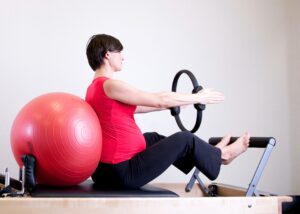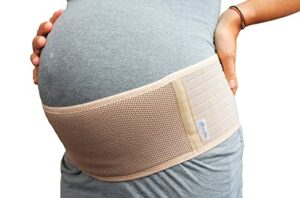This is a hot topic at the moment due to a recent study, published September 28th 2022. The results of the study showed that ‘children of women who used paracetamol during pregnancy were 23% more likely to display sleep problems and 21% more likely to display attention problems compared to those whose mothers did not use acetaminophen (paracetamol) while pregnant‘.

This is an important study and has highlighted the need for further research in this area. It is not yet clear what amount of acetaminophen can or cannot be taken, in what trimester the effects take place or how frequently the drug needs to be taken to have an impact. What we do know, is that it is better not to take anything unless absolutely necessary and to always look for pain relieving alternatives first.
So what are my other options for pain relief when pregnant?
First of all, it depends on the SIN factors of your pain (in other words, the severity, irritability and nature of the pain). This means that you need to assess how quickly your pain comes and goes and how severe the pain is when it is present. It is also important to know what type of pain you are feeling, is it stabbing, shooting, burning, tingling or maybe even a mixture?
Try to rate your pain out of 10, zero is no pain and 10 is the worst pain imaginable, where would you put your pain at the moment?
0 1 2 3 4 5 6 7 8 9 10
What about first thing in the morning? Or during certain movements?
For instance, some lower back pain can be constant but mild and increase as your day goes on, reaching no higher than a 5 out of 10 but no lower than a 3 on the pain scale. This type of pain tends to respond better to home remedies like aromatherapy and hot and cold applications and TENS.
Sharp, stabbing, intermittent pains, that might reach an 8 or 9 out of 10 but have periods with zero on the pain scale, tend to respond better to specific exercises, support belts and taping.
So, lets now have a closer look at some of your treatment options for pregnancy related pains.
Essential Oils:
Studies have shown that essential oils can be safe and effective in treating pain during pregnancy. The three most commonly used and heavily researched essential oils, associated with pain in pregnancy are; ginger, lavender and peppermint.
Research has backed the use of essential oils during pregnancy for many years, but a few small-scale studies have suggested that they are best avoided in the first trimester. Please always do your research on the safety, quantity and quality of essential oils before purchasing and make sure you are buying from a trusted manufacturer.
Essential oils can be used in a few different ways (depending on what you are trying to treat); aromatherapy might be the most well known and is probably the safest. This is where a diffuser is used to release the oil into the air, allowing it to be inhaled. There are also essential oil lotions that can be massaged into the site of pain and drops that can be added to hot water to soak in. Often combining aromatherapy with a treatment like massage can be most effective.
When it comes to headaches, local topical treatment with peppermint oil, over the temples, has proven to be significantly more effective than placebo in controlled studies when treating cluster-type headaches and chamomile oil has proven to be effective on migraine type headaches. Lower back pain has been treated successfully with acupressure using aromatic lavender oil and another study showed that patients whose massage contained ginger oil experienced better outcomes for longer periods of time with their pregnancy related symptoms (compared to placebo).
Massage:
Research suggests that massage therapy, compared to no treatment, should be strongly recommended as a pain management option. This small scale study found that having massage therapy twice a week, for 5 weeks during pregnancy, resulted in reduced anxiety, improved mood, better sleep and less back pain.
Always find a qualified pregnancy / prenatal massage specialist to ensure you and your baby are safe throughout this type of treatment.
Exercise:
Evidence is very strong when it comes to exercise and strength training for pain. Studies have found that exercise helps to reduce the risk of low back pain in pregnant women and when compared to no exercise, evidence shows that prenatal exercise can decrease the severity of low back and pelvic girdle pain during and following pregnancy.
There are lots of options when it comes to exercising during pregnancy, most exercise is safe but avoid very heavy lifting and contact sports to keep you and your baby safe. Have a look at all the different exercise options and adaptations available, in our blog.
Pilates is one of the exercises that has a lot of research backing it’s use in pregnancy. Here are some options of Pilates classes available online.
TENS machines:
Transcutaneous electrical nerve stimulation (TENS) is a nonpharmacological intervention that uses electrical impulses to disrupt pain signals that are being passed from the body to the brain. Studies have shown that TENS can help with reduction in pelvic pain, lower back pain and even pain from chronic conditions like fibromyalgia.
Always speak to your midwife or GP before using a TENS machine to check it is the right course of action for you (and your baby). TENS is thought of as a rapid but short-term answer to pain relief and is usually recommended in conjunction with other treatments. There are many different TENS machines available to buy, so if you are thinking of TENS as a treatment option then have a look at our Top 5 options here.
Pregnancy Support Belts:
Pregnancy or maternity support belts have grown in popularity more recently but have been used for many years. There is a lot of good quality evidence available for the use of support belts during pregnancy. THIS study concluded that wearing a support belt during pregnancy can reduce lower back pain and pelvic girdle pain, improve general function and mobility and reduce the risk of falls during pregnancy. Another study that we came across found that support belts are even more effective than exercise for prenatal symptoms.
There are currently no studies to show which support belts work best or for how long you should be wearing them, so we have put together our top 5 choices (here) to help guide you based on what they can help with and what we like about them.
Pregnancy support Pillow:
Another growth in the prenatal market is with pregnancy or body pillows. These pillows are said to help align the spine, prevent back (supine) sleeping and provide a neutral hip / pelvic position. They come in all different shapes, sizes, colours and patterns now (there are even pillows that enable you to sleep on your front during pregnancy), however, it is very hard to find evidence to back their use. This isn’t to say that they don’t work, it’s more likely that there just hasn’t been a need to carry out a lot of studies on them as of yet. Having said that, we did stumble upon one interesting study that looked at the use of body pillows combined with Physiotherapy and they concluded that the addition of the pillow helped to reduce symptoms of chronic lower back pains, compared to Physiotherapy alone.
If you think you would like to try a pregnancy pillow (bearing in mind that they are also really useful for feeding the baby on once he or she arrives) then have a look at our list of favourites here.
Kinesio Tape:
If you’re looking for a treatment that has been thoroughly researched, then Kinesio-taping is a good place to start, although, some of the research that you come across has been funded by the manufacturers, so always bear that in mind. Having said that, evidence is fairly strong when it comes to the effects of taping for lower back pain, upper back pain and when combined with strength training.
Taping is a safe and simple treatment to try for a lot of pains in pregnancy, the only thing to watch for with tape use is allergies, keep an eye on the skin where the tape has been applied and if you feel any discomfort, itching, burning then remove it straight away.
Have a look at our pages on taping for upper back pain, lower back pain and elbow pain for more information on how this treatment works and how you can apply your own tape (or have your partner or friend help you).
Heat / Ice:
Evidence suggests that heat and / or Ice can be beneficial (particularly in the short term) for pain relief in the back and when it comes to pelvic or period-type pains. Ice is usually sought when an injury is acute (first 48 hours) and heat is usually better if the pain has been lingering for a few days or weeks. You can use a hot-water bottle as a good heat source or get yourself a wheat-bag that you heat in the microwave (the heat from these usually last about 15 minutes). There is also the option of the heat patches like these which last about 12hrs and are self adhesive.
When using ice, do not apply for longer than 15 minutes as this can slow the bodies natural healing processes and never apply ice directly to the skin as this can leave burns. Ice should be used 2-3 times a day for the first few days after injury or after the pains started. You can also try alternating heat and ice, 5 minutes of each over a 20 minute period, this can help with pain, inflammation and swelling.
Physiotherapy / Chiropractic and Osteopathy treatments:

Although Physiotherapy, Osteopathy and Chiropractor treatments can be very different, they can also overlap somewhat. There is good evidence behind the use of all of these therapies in pregnancy and there is no ‘one size fits all’ when it comes to choosing who to see, some of it simply comes down to personal preference and to the experience and expertise of the individual practitioner. Always seek out a qualified women’s health, pelvic or pregnancy specialist within their field of practice. They will have additional qualifications and have much more experience working with pregnant and postnatal ladies.
Acupuncture:
Acupuncture has been used for hundreds of years and is considered an effective treatment option for pain in pregnancy. This is another area of therapy that has been heavily researched with positive results. The research available suggests that acupuncture is a safe and effective for treating many conditions including; back, pelvic, shoulder, elbow and neck pain.
Please note that there is no statutory regulation of acupuncture in England. If you choose to have acupuncture, it is recommended that you check the acupuncture practitioner is either a regulated healthcare professional such as a doctor, nurse or physiotherapist or a member of a national acupuncture organisation. For Physiotherapists, you can look on the AACP website and find registered practitioners with details of what they specialise in.
Trigger Point Therapy:
This is a therapy option that you might not have heard of. Trigger points are what we often refer to as ‘knots’ in muscles. They are made up of bunches of muscle fibres (withing a single or multiple muscles) that stay contracted because the muscle(s) in question is being overloaded or overused.
Releasing the trigger points (or knots) is a really nice way to provide some instant pain relief but rarely cures the issue, as you are treating the symptoms and not the cause. We therefore often combine trigger point release therapy with exercises or manipulative therapy (but sometimes its just nice to have that instant pain relief available during pregnancy because often the cause goes away on it’s own once the pregnancy ends).
Trigger point release is perfectly safe during pregnancy and can be done in a number of different ways. Often a massage therapist, physiotherapist or acupuncturist will work on these knots for you in your therapy sessions, but you can also do it yourself and still get the same benefits. Upper back (thoracic) pain often responds really well to trigger point releasing, as does neck and glute pain or sciatica. Have a look at the links to the pages for more information on how to self treat (it’s really simple and gives instant results).










